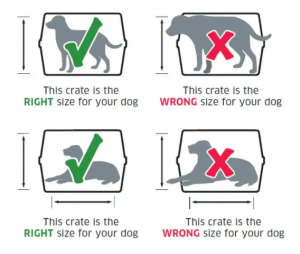Moving makes us stressed & anxious. Moving with our fur-babies is even harder.
Dogs like routine. It doesn’t matter whether it’s your routine or theirs, they’ll notice that something is happening.
Changes in your routine will increase your dog’s stress levels, and that will increase yours.
Not all moves were created equal. There are certain actions you can take that will reduce pressure both from you and your little pal.
Table of Contents
Plan Your Move
Make sure you have a plan in place prior to beginning your move. There are many factors to keep in mind when you are planning to move and have a dog. It can be absolutely disastrous when you do not have a plan in place when moving homes with your dog.
Without proper planning your dog can become stressed and possibly experience health problems such as an upset stomach, diarrea, or nausea. There is also the possibility of your dog becoming injured when packing or traveling to your new home. A solid plan that is followed is always best when you are moving with your dog.

No matter if you are planning to move across town or to an entirely different city, you will want to research dog laws and regulations. If your dog is a breed that tends to be highly regulated, you will want to know what special licenses are needed or if your dog is even allowed in your neighborhood.
Some cities do require each dog to be recorded and licensed. Check with your city’s animal control or city council to find out about licensing requirements. You can also go online to check if your new state has breed specific legislation. This is a great resource when you have a breed that is heavily legislated.
Set a Timetable
Make a schedule and stick with it as much as possible to ensure you get everything done in a reasonable amount of time. You do not want to feel pressure or stressed because you have not properly planned things out. Your dog will also feel your stress and could cause them to act out or weaken their immune system.
Book Your Flight
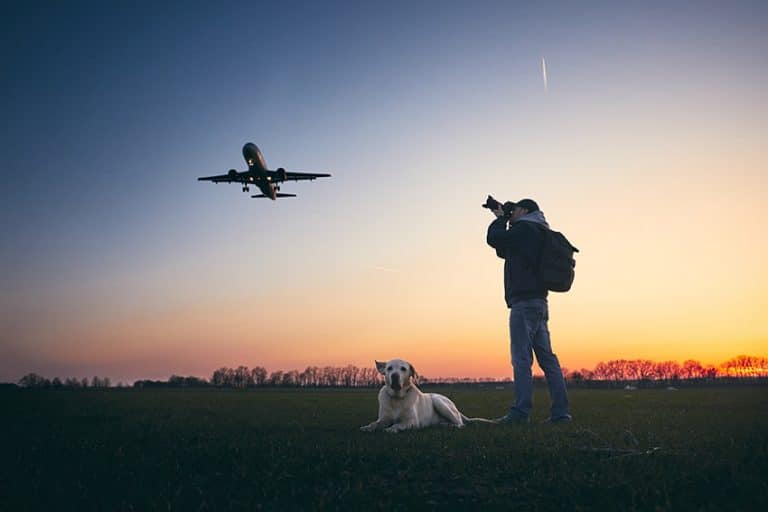
When you have to move across the country, you will probably need to travel by plane rather than make a long drive cross-country. There are many things to consider when you are going to book a flight for you and your dog.
Once you have figured out if your dog can travel in the cabin with you or if they have to travel in cargo, you will want to book their passage. Start a checklist to make sure your dog is safe and secure during their flight.
Cabin vs. Cargo
If you have a small dog that will fit in a carrier under your seat, then having your dog in the cabin with you is ideal. This way you can reassure your dog during the flight. Medium, large, and giant sized breeds will have to fly in cargo unless they are a working service animal. Flat faced or braychycephalic breeds such as Bulldogs, Pugs, Shih Tzu, and Japanese Chins have been banned from flying in cargo. Check with your airline for a full list of breeds that cannot fly in cargo.
Book Your Dog’s Ticket
Whether flying in cabin or in cargo, your dog will require their own ticket. Check with your airline for pricing but typically, dogs that fly in cabin will cost about $125. Cargo prices will vary depending on the size of the crate and can cost between $200 and $600 or even higher for giant breeds.
Buy an Approved Travel Crate
There are only certain dog crates are permitted on airplanes. IATA-compliant crates are only accepted and if you do not have your dog in an approved carrier they will not be allowed to board the plane.
It can be daunting when searching for an airline approved dog crate. We have taken some of the guesswork out of picking the right crate for your dog to keep them secure during their flight. You will want to find a dog crate that properly fits your dog and keeps them safe.
Medium and large sized dogs will most likely have to fly in cargo and those crates must be hard sided. The crate also has to screw together and cannot be held together by slide snaps. Your dog will be required to have enough room to stand up and turn around. Too much room in their crate can cause injury when jostled during the flight.
Small dogs can fly in the cabin with you but they must still be in an airline approved crate. The crate can be soft-sided or hard-sided but must fit under your seat. Your dog must fit comfortably within the crate and be able to stand up and turn around.
Prep Your Dog for the Move

When you decide to move, it will be a big deal even without the added stress of ensuring your dog is kept safe and stress-free. Prepping for the move is a good way to ensure your dog’s transition goes smoothly.
Update Your Dog’s Pet Insurance
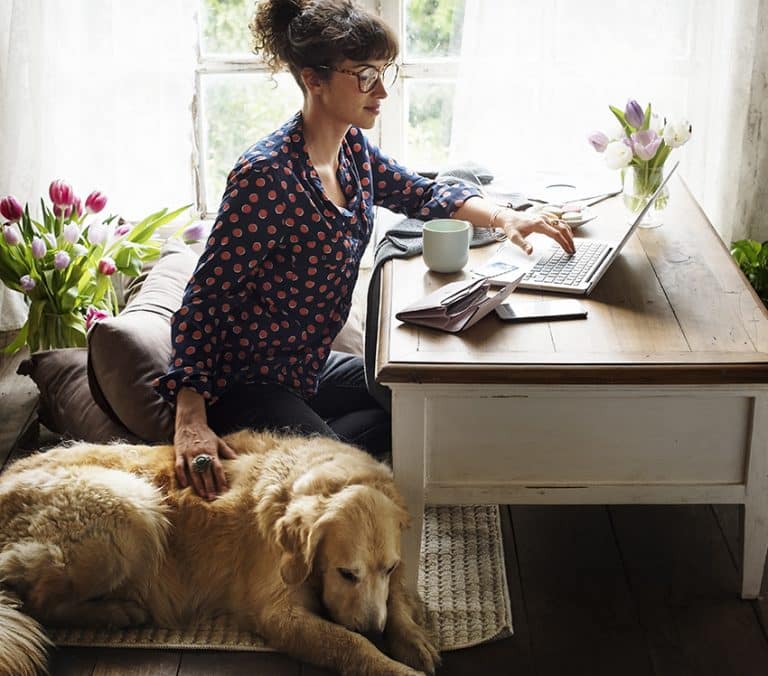
Dog health insurance is becoming more and more popular with the rising cost of veterinary care. You may have already purchased pet insurance for your dog and if so, you will want to contact your insurance company and inform them you are planning to move. Have your new contact information and veterinarian’s information ready when you call or email them.
Ask The Vet Checklist
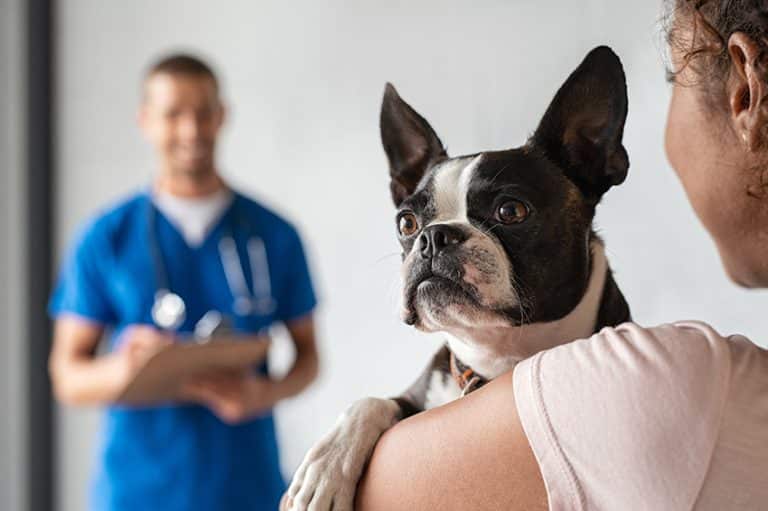
Before you make an appointment with your veterinarian, you will want to make sure you have a list of questions as well as a checklist for everything that will be needed to make the transition to a new veterinarian. It is always better to have a checklist so you do not forget anything. Your checklist should be something similar to the following:
#1 Make sure you have all the right paperwork in place
- License : Depending on where you are moving, you may need to have your dog’s city or county license updated. That may require paperwork from your veterinarian and current vaccinations.
- Vaccination Paperwork: Your veterinarian will give you a printout listing the dates and types of vaccinations your dog has had. You will want to put this printout with the rest of your paperwork so you have proof your dog is current on their vaccinations.
- Medical Records: Medical records for your dog will include dates of surgeries, current medications, any pre-existing health problems and dates of diagnosis. Your veterinarian can print out your dog’s medical records or they can fax them to your new veterinarian.
- Health Certificate: If you are crossing state lines, you will be required to have a state health certificate within 30 days of traveling. When flying, your dog will need to have a health certificate that was issued within ten days of the flight. Make an appointment with your veterinarian and they will issue a health certificate after examining your dog. A state issued health certificate verifies that your dog has been examined by your veterinarian and given a clean bill of health regarding any communicable diseases and parasites. USDA/APHIS has set regulations to ensure that pets crossing state lines are healthy and not a health risk to other pets they may come in contact with.
- Rabies Tags: No matter where you are moving, a rabies vaccination is always a good idea. Most cities will require your dog be currently vaccinated against rabies. Your veterinarian will provide you with a tag to put on their collar and a certificate to put with their paperwork.
#2 Parasite Treatment/Preventative
When you visit your veterinarian, have a fecal exam done to make sure your dog is not harboring any worms. If necessary, have your dog de-wormed. Have a heartworm test done if your dog is not currently on heartworm preventatives. Flea and tick treatments are a great idea since you may not know what pests will be near your new home.
#3 Microchip Your Dog

Microchipping your dog is a great tool for locating lost pets. A microchip is implanted between the shoulder blades of your dog using a hypodermic needle. Most dogs are microchipped during a routine vet visit, but can also be done when your dog is under sedation.
The cost to have the microchip implanted will vary depending on what your veterinarian charges, typically between $35 and $45. Usually the cost will include the procedure and registration in the microchip database.
There are several different types of microchips available. Talk to your veterinarian about which type of chip is best for your dog. Many AKC registered dogs can be microchipped with the Re-Unite chip and be registered within their database. One of the more popular microchips within the United States is the Home Again chip.
#4 Anti-Anxiety Methods
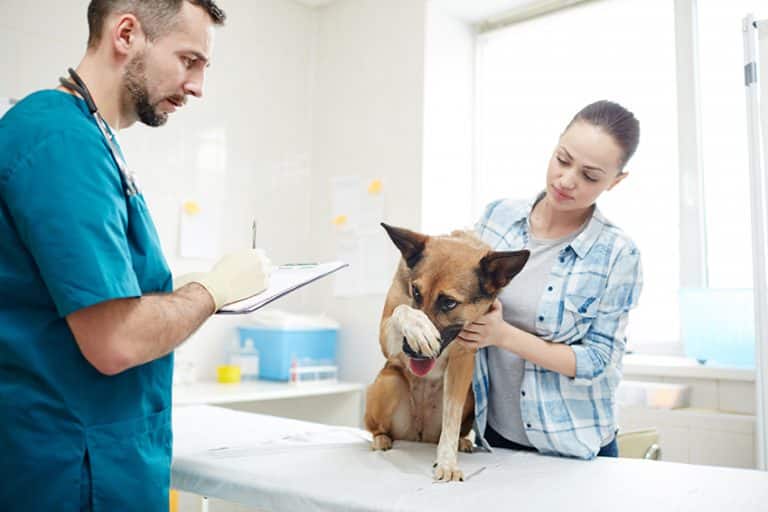
You will want to discuss anti-anxiety medications and methods with your veterinarian when you take your dog in for their vaccinations and health certification. Dogs with severe anxiety will probably need medication to help alleviate the stress and anxiety they are feeling. Aside from medications, there are other methods to help calm your dog such as:
Dog Anxiety Vest
Many people who have dogs with severe anxiety issues have great things to say about the Thundershirt calming vest. With an over 80% success rate, the Thundershirt may be a great solution for your dog if they suffer from severe anxiety.
Dog Calming Collar
There are several different calming collars on the market, but many dog owners use the Sentry Calming Collar for dogs to help alleviate stress and anxiety. This collar releases pheromones into your dog’s body for up to 30 days to modify behavioral problems.
Anti-Anxiety Supplements
- Zesty Paws Calming Bites are a natural treat you can give your dog to help calm them and bring their anxiety levels down.
- Vet’s Best Comfort and Calm supplements are a natural treat formulated to keep your dog’s anxiety levels low.
- HomeoPet Homeopathy treatment is a natural supplement that helps to calm your dog during travel and helps lessen their anxiety levels.
- CBD Oil for Dogs can have a calming effect on dogs but there has not been enough research done to actually prove CBD oil will help your dog’s anxiety. Talk with your veterinarian about the use of CBD oil for anxiety in your dog.
Interview New Veterinarians

If you are moving to a different city and your veterinarian is no longer accessible, you will need to start searching for a new veterinarian. When moving out of state, look up veterinarians near your new home and begin calling them. You can even use MyPet.com’s Vet Finder to search for a new veterinarian.
Have a list of questions prepared and get a feel for the veterinarian’s practices and policies. Remember, you will not get an accurate feel about a new veterinarian until you actually meet them in person and see how they interact with your dog.
ID Tags and Other Information
It is always a good idea to keep your dog’s ID tags updated. When you are in the process of moving and even when you get to your new home, make sure your dog has their ID tags on a collar. Put your cell phone number on the tag so you can be found even if you move to your new home. Then you will want update your address once you have officially moved.
Crate Training is a Must
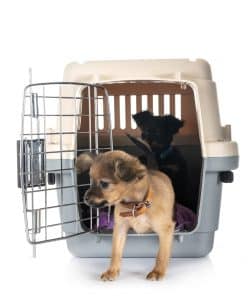
No matter if you are flying or driving with your dog, crate training is important. You want your dog to see their crate as a safe haven, or their den. Include a favorite blanket and toy in the crate so they know can become comfortable. Their safe zone during the chaos of moving will become their crate.
Make a First Aid Kit
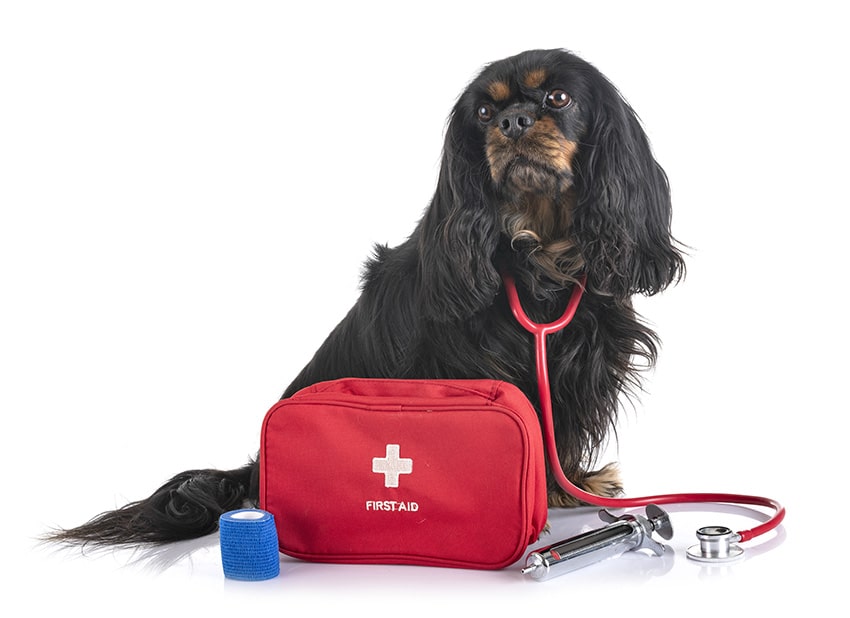
It is always a good idea to have a first aid kit packed for your dog; you do the same for your family. When you are traveling, having a first aid kit is essential. When driving with your dog, have the kit easily accessible in the car. When flying with your dog, tuck a first aid kit in your carry-on bag so you can get to it easily.
- Hydrogen peroxide
- Alcohol pads
- Emergency phone numbers
- Copy of vaccination records
- Gauze, tape, scissors
- Antibiotic ointment
- Toys and treats
- Wet wipes
- Tick removal tool
- Anti-nausea tablets or liquid
- Anti-diarrhea tablets or liquid
Checklist for Moving with Your Dog
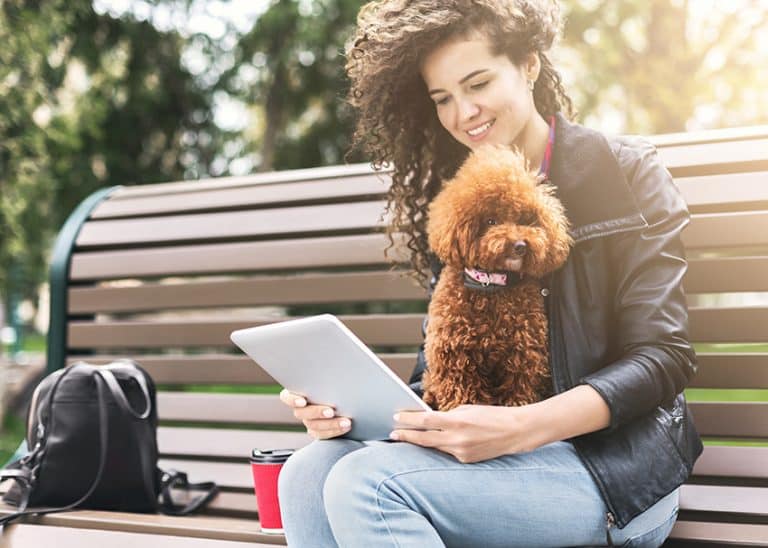
When you plan a trip you probably make a checklist of things to do and pack for yourself. The same should be done when you are going to travel with your dog. Make a checklist to ensure you have everything ready when you travel to your new home with your dog. Also check out our article on traveling with your dog for more tips and pointers.
- Paperwork including vaccination records
- Pet Insurance and Documentation
- Food and water
- Bowls
- Poop bags
- Leash and collar (with ID and Rabies tag)
- Crate and blanket or dog bed
- Toys and treats
- Anxiety relievers
- Current photo of your dog
- Proof of Ownership
- First aid kit & Plans for an Emergency
Stress-Free packing
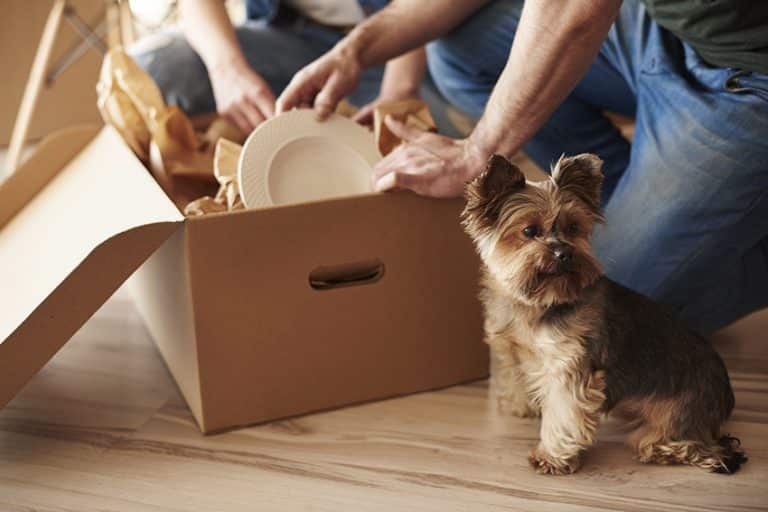
There is a lot to do when you move including packing up your belongings and cleaning your house. Deciding what to take with you and what to get rid of can be stressful, so can having boxes stacked everywhere.
Your dog may begin exhibiting high stress levels when they see boxes piling up and your house emptying.
You will have decisions to make regarding your dog during the packing process. You may have to place your dog with a friend or in a boarding kennel if the stress is too much for them. Otherwise, you will want to include them in the packing process so they do not feel as upset or left out.
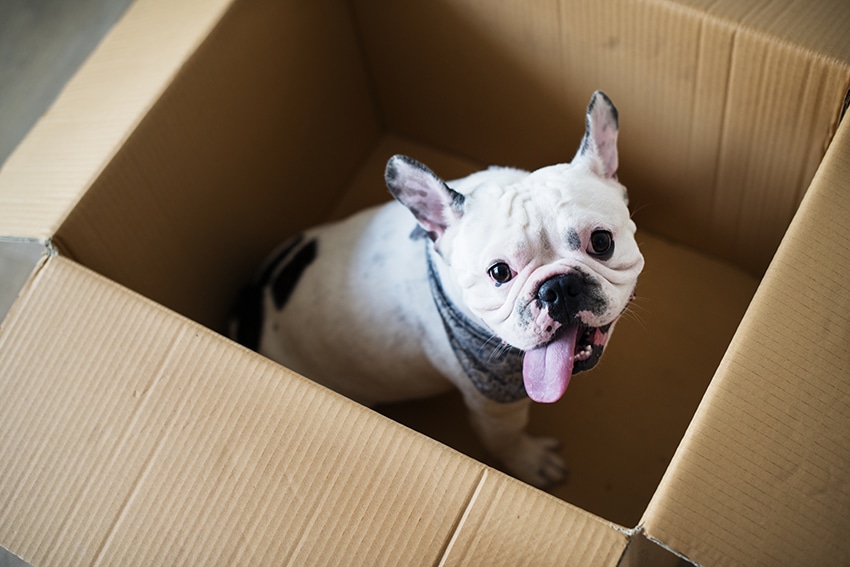
Involve Your Dog in the Packing
Let your dog be involved in the process. Do not lock them away in a different room while you are sorting through things and packing. Your dog will be curious, let them sniff the boxes and watch all you do while packing.
Check Out Your New Home
If you are moving to a new home nearby, take your dog over to the new house and let them explore. Bring a few of their favorite toys with you and a blanket or bed so they have something familiar. Play with them in the backyard and walk with them through the house.
A few trips over to the new house before the final move will help your dog become comfortable with their new home.
Pack Your Dog’s Things Last
Do not pack up your dog’s toys or bedding until the very last. If you pack them before you are ready to make the final move to your new home your dog will begin to feel displaced. They need their toys and bedding to make them feel safe and secure, by packing those too early you will create unnecessary anxiety.
Stick with the Familiar Routine
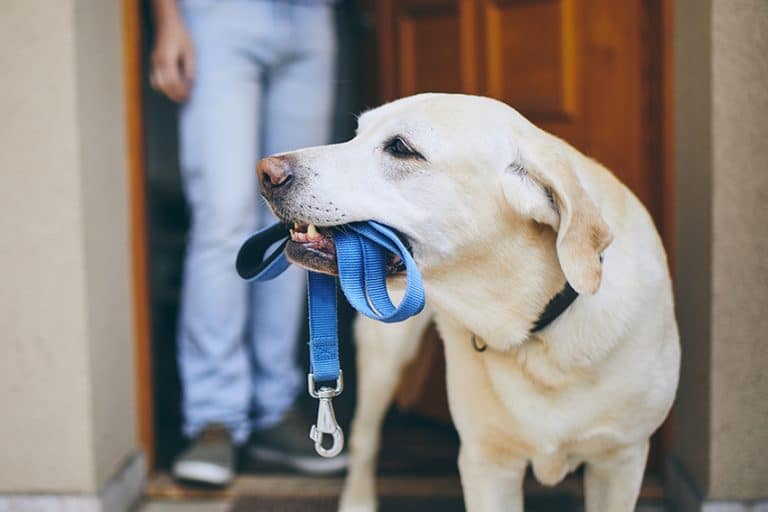
Throughout the packing process do not steer away from your dog’s normal routine. Make sure they are fed at the same time and their food bowls are in the same place. Take your daily walks at the same time. Bed time should also not change. Changing your dog’s routine will cause stress and could cause them to act out.
Don’t Let Crate Training Lapse
Crating your dog during the move is a good way to ensure they are kept safe and have a safety place to go to when things get too stressful. Make sure your dog spends time in their crate a few times each day. If you are going to have to fly to your new home, your dog will need to be very comfortable in their crate for the flight.
Control your dog's stress levels

While it may seem a bit callous to say this, if your dog is one to stress over changes to their daily routine or upheaval within the home, it will be easier on you and your dog if they were not present while you are packing your home up and preparing to move. This is also true for the un-packing process.
No, you will not be a horrible dog parent if you chose to remove your dog from the equation and have them stay with a family member, close friend, or even a boarding kennel during this period of transition.
This gives you the freedom to get your home packed up and shipped off without having to worry about the stress it is causing your canine companion. Once you have set up your new household, send for your dog if you have moved far away or go pick them up and bring them to their new home which will be all ready for their arrival.
Move Smoothly

Moving by car
Most of the time when you move, you will be staying within driving distance of your former home therefore, you will probably travel by car with your dog to your new home. You will want to make sure the trip is as smooth as possible to keep your dog feeling secure.
Check the Weather Forecast
Traveling during the winter can be tricky but no matter the season keep an eye on the weather forecast so you are not caught off guard. Traveling through an area prone to flash flooding during a rainstorm may not be the best route to take. Planning your move during a snowstorm is also not ideal. Plan ahead for inclement weather and have alternate routes.
Limit Food Intake
You do not want to have to stop every hour to let your dog out to go potty. You also want to limit their food to help with car sickness. Plan on giving your dog small snacks throughout the trip not large meals and once you get to your destination you can give them their regular portion sizes.
Keep Your Dog Safe
- Seatbelt
- Seat Covers
- Harness and Collar (Glow in the Dark)
- Anxiety Vest
Don’t Let Your Dog Hang Out of the Car
Flying debris can hit your dog and cause injury. It is best to keep them contained inside the vehicle and not hanging their head out the window. If your dog likes to feel a breeze while in the car, crack the window but not far enough where they can get their head out.
Install a dog window guard so your window can be down but nothing can fly into the vehicle and your dog cannot stick their head or feet out the window.
Never Leave Your Dog Unattended
Your car can quickly become a death trap for your dog in the summer and in the winter. Cars heat up quickly during warm weather and your dog can quickly suffer from heat exhaustion or heat stroke and can die.
In the winter, cars quickly become cold, kind of like a freezer or refrigerator. Your dog can then become too cold and suffer from hypothermia and could potentially die.
Have Rest Breaks Planned
Plan your route and have scheduled breaks planned. When traveling with a dog you will want to plan to stop every three to four hours for 15-30 minutes to stretch, get a drink, and go potty. Senior dogs and puppies will probably need more frequent stops. I generally plan to stop every two to three hours when I have a puppy or senior dog with me.
Research Pet-Friendly Hotels
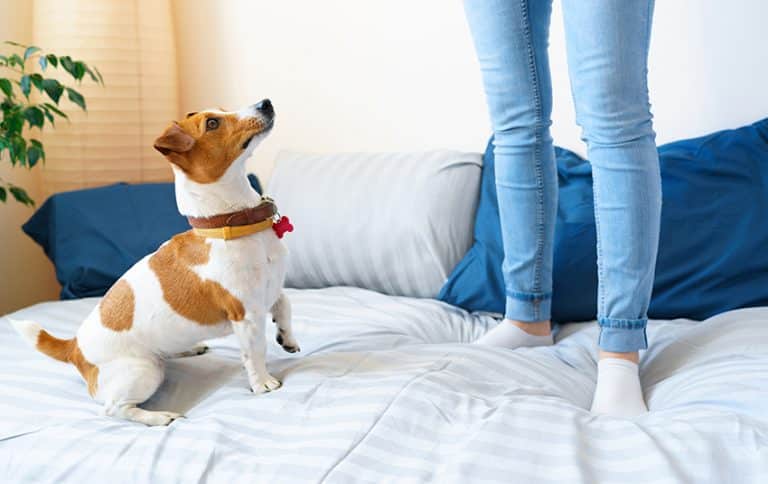
If your trip will take longer than a day, be sure to research different pet-friendly hotels along your route so you can find a hotel where you and your dog will be welcome. Many hotels do require a pet deposit and/or your dog must remain crated while in the room.
A great resource for people traveling with their dogs looking for pet friendly hotels within the United States is PetsWelcome.com. You can also check BringFido.com for hotels along your route for a stress-free trip to your new home.
Moving Across The Country By Plane
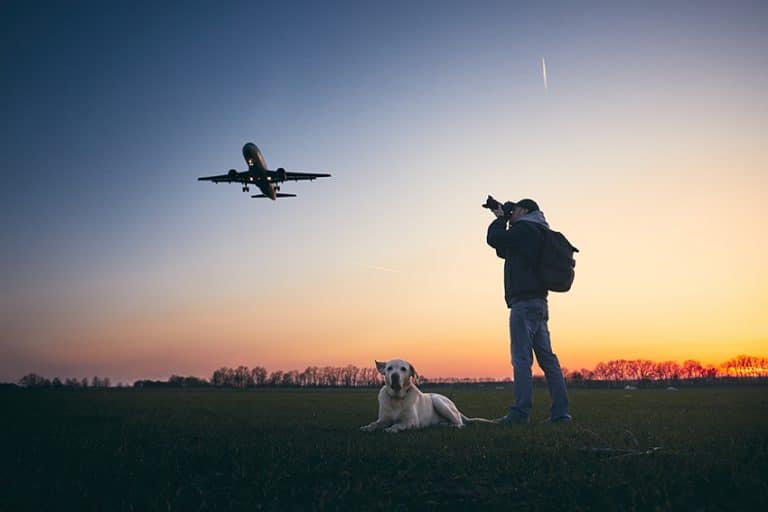
There may be times when you have to move across the country. If that is the case, you will probably want to fly rather than drive. Research the best way to fly your dog and make sure they are fully comfortable within their crate so they do not become overly stressed during the flight.
Limit Food Intake
Your dog will not be able to go out and go potty once they have been checked into cargo or you board the plane with them in cabin. Limiting their food will help them from not having to soil their crate. Limited food will also help if they have an upset stomach from the stress of traveling. Once you get to your destination, you can resume regular meals.
Keep Your Dog Hydrated
Make sure your dog has had plenty of opportunity to drink before checking them into cargo. As soon as the flight lands and you can retrieve your dog from cargo offer them a drink. If they are flying in-cabin with you, offer them small drinks throughout the flight with a collapsible water bowl or a dog bottle. Staying hydrated will help your dog adjust better to the pressure of the flight.
Have Proper Identification for Your Dog
If your dog is in cargo make sure the crate is properly marked with your dog’s name, your name, phone number, and address. Have ID tags on your dog’s collar in case they get out of their crate. When in cabin with you having proper identification is not as important but you still want ID tags on them in case they get away from you at the airport.
Keep Your Dog’s Important Documents Handy

Pack your dog’s important documents and health records in a folder in your carry-on so it is handy. Make sure your dog’s most current health records are in the front of the folder for easy access. Put a current photo of your dog in the folder as well.
Keep a Check on the Weather
Long delays can cause undue stress on your dog. Be prepared for any situation and know what the weather is expected to be in each city your plane with land. When your dog flies in cargo, there are certain temperatures when they will not be able to fly unless you have climate acclimatization form signed and dated by your veterinarian.
Research In-Terminal Pet Rest Areas
With so many people now traveling with their pets in cabin, airports have stepped up their game and added in-terminal pet rest areas where you can let your dog stretch their legs and spend some time outside their crate during layovers. Research the airports you will be visiting and see if they have an in-terminal pet rest area.
You can check online for pet-friendly airports such as St. Louis International, Denver International, and Detroit Metropolitan. PetFriendlyTravel.com has a list of other pet-friendly airports throughout the United States.
Dog Flying Checklist
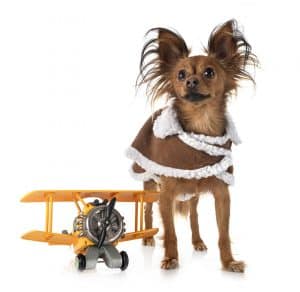
- Crate
- Important Papers
- Pet Insurance and Documentation
- Collar (with ID and Rabies tag)
- Leash/Harness
- Proof of Ownership
- Food/Treats
- Anti-Anxiety Vest and/or Supplements (if needed)
- Toys
- Blanket/Pillow
- Poop Bags
- Water Bowl or Bottle
- Muzzle
- Grooming Supplies
- First Aid Kit
- Plans for an Emergency
Introduce Your Dog To Their New Home
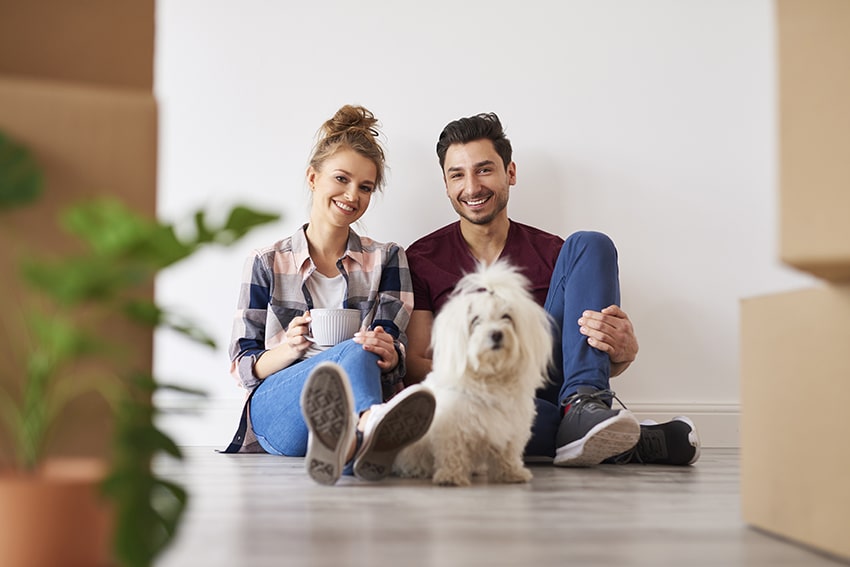
It can be scary for your dog to leave every familiar sight and smell behind. Your new home will not look or smell like your old one so it will take a while for your dog to feel like they are home. The first thing you want to do is set up your dog’s things so they have familiar items around them.
Dog Friendly Places

Before you give your dog free reign in your new home or yard, be sure to do a thorough inspection of the property and look for potential hazards.
You will want to actually get down on the ground and look for potential problems. This puts you at the same level as your dog and helps you spot things that could cause harm to your dog. It also allows you to see any possible escape routes from the yard.
Things to look for include any exposed electrical cords that may tempt your pup. Also look for holes in cabinets, walls, or under staircases where they could get into trouble. Finally, look for any type of pest control poisons or cleaning products that your dog could get into.
When checking the yard, walk along the entire perimeter fence to ensure there are no holes or loose boards where your dog could get out. Dogs that dig will try to find a way down and out so investigate the construction of the fence and if necessary install a barrier to prevent your dog from digging out.
Stairs can also potentially pose a problem for your dog if they are not used to having to climb steps. Elderly or disabled dogs also would have a problem with stairs. A security gate can easily be installed to keep your dog from climbing any stairs and possibly getting hurt.
Take a Walk around the Neighborhood

Take a stroll around the new neighborhood. Plan to take an extra long walk because your dog will want to explore everything along the walk. They will probably be on sensory overload so be patient. Let them explore everything but do not let them be obnoxious around new neighbors.
Establish a Routine
You will want to keep their new routine as similar to their old routine as possible. Dogs truly take comfort in their day-to-day routine. Set their feeding schedule, their nap times, and walks within 30 minutes of their former routine. If you need to make adjustments, do it slowly to minimize stress.
Register with Your Dog and Get Your License
Once you have moved in, head down to animal control or city hall and register your dog with your new city. Bring along all pertinent paperwork including veterinarian reports, health certificate, proof of vaccinations, and even a photo of your dog. Most dog licenses do require a small fee. Check with your new city about any ordinances and licensing requirements.
Meet your dog's new Vet
Now that you are in your new city, make an appointment to meet your new veterinarian. Bring all the paperwork from your former veterinarian so your dog’s health records are in one place.
After meeting your new veterinarian you will have a better knowledge of whether or not they are a good fit for you and your dog. Do not be afraid to check out a few different veterinarians to find the right one. You would do the same for your human child, so take the time to find the right fit for your pooch.
Research and Visit a Local Dog Park
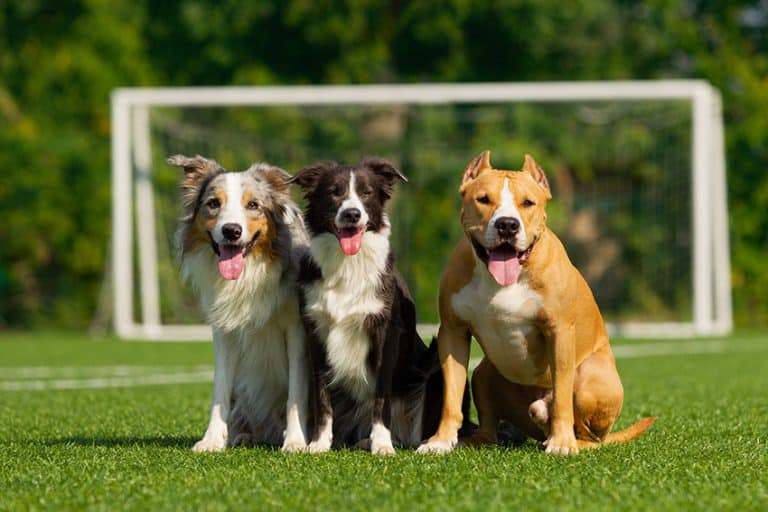
While I am not a fan of dog parks, I do understand the needs of a dog. They are social creatures and love to have other canines to play with. Do your research and pick a dog park that enforces its rules and regulations. If you have a small dog, you want a park that lets you keep large dogs away from your small dog.
Once you have found a dog park you are comfortable with, visit in person without your dog and watch how the other dogs interact. If you are still on board to give that park a try, bring your dog for a visit. Other dog owners will be a wealth of information regarding dog-friendly places within your new city.
Final thoughts...

Moving is a very stressful time, moving with a dog makes it just that much more stressful. By following the tips and tricks introduced, you will be able to minimize the stress your pup feels and help them feel more secure during this time of great upheaval.
Remember to reassure your dog at each point in the move from packing your old home up to traveling to your new home and then the initial introduction to your new home. Your dog will sense your anxiety so keep things as calm and upbeat as possible so they can feel safe and cherished.


